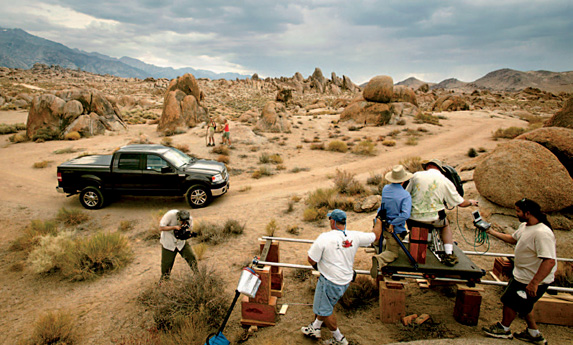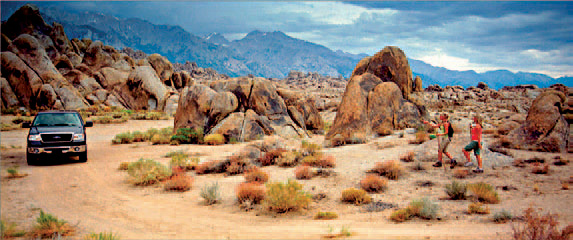"As Good As It Gets" Introductory Notes
|
Read more
at in70mm.com The 70mm Newsletter |
| Compiled by: Paul Rayton | Date: 05.07.2007 |
 In 2006, Kodak and Arriflex, plus the L.A. lab known as "FotoKem" cooperated
to produce a new demonstration film, to illustrate the significant benefits
of shooting on 65mm film. In 2006, Kodak and Arriflex, plus the L.A. lab known as "FotoKem" cooperated
to produce a new demonstration film, to illustrate the significant benefits
of shooting on 65mm film.Of course, we all know about shooting a larger negative, and how it delivers a better image, but a lot of people -- even those working in the industry! -- do not understand this. And, with the increasing use of "D.I.s" ("Digital Intermediates") in post-production work, it was important to be able to illustrate to the people out there that even using these D.I. processes, that they could significantly enhance their exteriors, esp. long shots and grand vistas, by using 65mm for the original photography -- and still have those image(s) be compatible with the close-ups and dialogue photography that might have been photographed on 35mm film or, possibly, even some kind of HD capture device. So, Director of Photography Bill Bennett, a member of the American Society of Cinematographers was selected to be the "DP" for the project. Mr. Bennett's most-often assignment, in his daily work life, is as a DP for automotive commercials, so you know that there would have to be some scenes of cars. But that wasn't to be it exclusively. In order to show the versatility of the photography, and the process, it was decided to have several exterior scenes, with some models, plus varied conditions and locations. The mountains of central California would be the location, and so photography was done near Lone Pine, in the Sierra mountains of central California. Various types of camera emulsions would be used, in varying light conditions. (All the specifics of those details can be found listed on the in70mm.com website.) Some of the exteriors were in full sunlight, but, as fate would have it, on one of the days of shooting there was a thin layer of high cloudiness, leading to a somewhat "flatter" light than would have been the most dramatic, ideal, for demonstration purposes. However, this was not a Hollywood production with an unlimited budget, and they couldn't wait days for the light to change, so they worked with the light they had at that time. |
More
in 70mm reading: "As Good as it Gets"- Demonstrates power of large format "As Good As It Gets" Introductory Notes ...about the showings “As Good as it Gets” - cast/credit ARRI 765 Film List Panavision and the Resurrecting of Dinosaur Technology Internet link: |
 After the mountains and forests and lakes, of course there had to be a few
scenes of "city" views, and that's were the automotive scenes enter into the
picture. There are several scenes of cars, traveling the highways around
central Los Angeles, as well as some evening "magic hour" views of the new
Frank Gehry-designed "Walt Disney Concert Hall", to show off the incredible
sharpness of the camera process. After the mountains and forests and lakes, of course there had to be a few
scenes of "city" views, and that's were the automotive scenes enter into the
picture. There are several scenes of cars, traveling the highways around
central Los Angeles, as well as some evening "magic hour" views of the new
Frank Gehry-designed "Walt Disney Concert Hall", to show off the incredible
sharpness of the camera process.At the first public demonstration viewings of this film, in November 2006, held at UCLA in Los Angeles, there were various versions of the movie shown, including a 35mm print from a D.I., a 4K d-cinema version using the Sony 4K projector, and of course, the 70mm print. After the evening presentations were completed, there was still a bit of time, and the audience (a bunch of Hollywood professionals, from various specialties in the post-production field) was asked, "what would you like to see repeated?" -- the answer was, the 70mm print. Clearly the audience favorite, and many of the younger people present had never seen actual 70mm film, actually projected "in the splendor of 70mm". The result spoke for itself. The film does not have a completely synchronized soundtrack. Rather, there is some specially-composed music to be played via a companion CD, with approximate synchronization. That's why you will now see the countdown leader projected, to help get the timing right ... |
|
|
Go: back
- top -
back issues
- news index Updated 22-01-25 |
|
